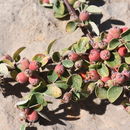en
names in breadcrumbs


Cotoneaster nummularius, the nummular or coinwort cotoneaster is a species of cotoneaster. This woody shrub is native to much of Asia and south eastern Europe.[2][3][4][5]
Cotoneaster nummularius is a mountainous winter deciduous woody shrub covered in alternate dull green rounded to oval-shaped leaves with fuzzy white undersides and blooms in clusters of 3 to 5 with white hermaphrodite flowers. It flowers from April to June; the fruits are red slightly felted pomes that darken to a bluish black color. It grows at altitudes between 1,400 metres (4,600 ft) to 2,000 metres (6,600 ft).[6][5][4]
The species is found in Greece, Crete, Lebanon, Syria, Israel / Palestine, Turkey, Cyprus, Iraq, Yemen, Oman, Saudi Arabia, Caucasus, Iran, Turkestan, Afghanistan, Tajikistan, Uzbekistan, Azerbaijan, Armenia, Gruziya, Caucasus, Pakistan, Northwestern India, China, Kazakhstan and Kyrgyzstan.[3]
Cotoneaster nummularis is used in folk medicine; decoctions made from the fruits is taken orally as an appetite stimulant, stomachic and expectorant.[7]
Cotoneaster nummularius, the nummular or coinwort cotoneaster is a species of cotoneaster. This woody shrub is native to much of Asia and south eastern Europe.